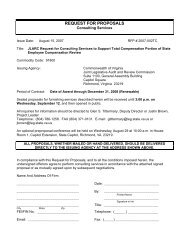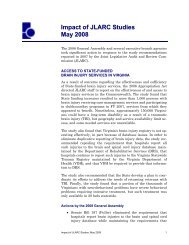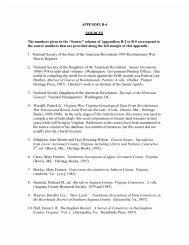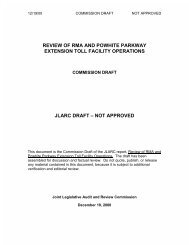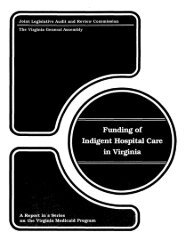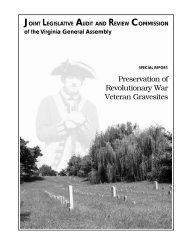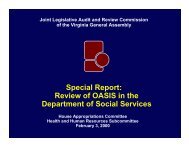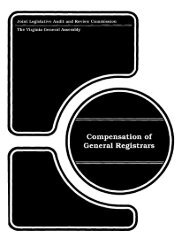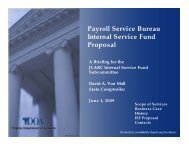Funding of Constitutional Officers - Virginia Joint Legislative Audit ...
Funding of Constitutional Officers - Virginia Joint Legislative Audit ...
Funding of Constitutional Officers - Virginia Joint Legislative Audit ...
You also want an ePaper? Increase the reach of your titles
YUMPU automatically turns print PDFs into web optimized ePapers that Google loves.
This recommendation has, for all intents and purposes, been<br />
adopted by the 1990 Session <strong>of</strong> the General assembly and will become<br />
effective July 1, 1990.<br />
In developing the Governor's budget, DPB used actual salaries<br />
budgeted by the Compensation Board, and determined fringe benefits<br />
at 7.65% for FICA, .02% for Group Life Insurance, and retirement at<br />
8.72%. Because the actual VSRS rates vary by locality from a low <strong>of</strong><br />
0% (Powhatan County) to a high <strong>of</strong> 11.94% (City <strong>of</strong> Franklin) the<br />
Compensation Board's actual cash reimbursement depended on the<br />
locality involved. Item 86 <strong>of</strong> Chapter 972 now limits the<br />
Compensation Board reimbursement for retirement to 8.72% or the<br />
locality's VSRS rate, whichever is lower. The estimated savings to<br />
the general fund (and resultant loss to localities) is estimated at<br />
$3,023,598 each year.<br />
Recommendation (5).<br />
The General Assembly may wish to direct the development <strong>of</strong><br />
uniform and consistent procedures for the distribution <strong>of</strong> state<br />
funding for non-personnel costs in the constitutional <strong>of</strong>fices.<br />
Options that could be considered are (1) a grant process based on<br />
proposals for funding from the constitutional <strong>of</strong>ficers and specific<br />
evaluation criteria for making each grant; or (2) a formula process,<br />
based on workload and staffing data which can be demonstrated to be<br />
related to non-personnel costs. Any revised process for funding<br />
non-personnel costs should recognize the ability <strong>of</strong> localities to<br />
pay for such costs.<br />
WE AGREE AND DISAGREE.<br />
The Development <strong>of</strong> procedures for the distribution <strong>of</strong> State<br />
funding for non-personnel costs would serve as a helpful guide in<br />
the decision making process. The Compensation Board DISAGREES,<br />
however, with the use <strong>of</strong> any formula as the only basis to allocate<br />
funds. Without repeating the arguments presented in the response to<br />
Recommendation (1), the Compensation Board maintains that<br />
inconsistencies between <strong>of</strong>fices (e.g., staffing, duties, level <strong>of</strong><br />
automation, etc.) do not allow the distribution <strong>of</strong> funds based on a<br />
formula. Further, any method <strong>of</strong> distributing funds which does not<br />
consider need cannot be viewed as equitable.<br />
Non-personnel costs for constitutional <strong>of</strong>ficers have been for<br />
the most part level funded by the General Assemply for the past<br />
three years, and are level funded again in the 90-92 Biennium.<br />
Consequently, local governments are picking up a greater share <strong>of</strong><br />
costs for constitutional <strong>of</strong>ficers. This occurs not only due to<br />
inflation, but due to additional positions being approved by the<br />
General Assembly without a proportional increase in non-personnel<br />
costs.<br />
87



